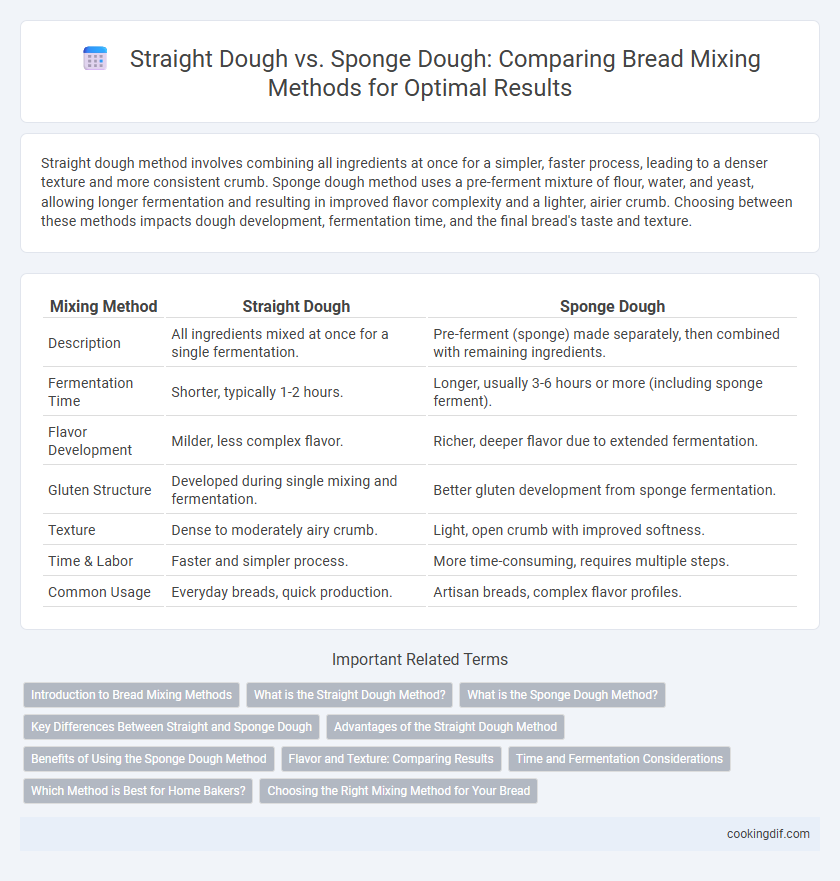Straight dough method involves combining all ingredients at once for a simpler, faster process, leading to a denser texture and more consistent crumb. Sponge dough method uses a pre-ferment mixture of flour, water, and yeast, allowing longer fermentation and resulting in improved flavor complexity and a lighter, airier crumb. Choosing between these methods impacts dough development, fermentation time, and the final bread's taste and texture.
Table of Comparison
| Mixing Method | Straight Dough | Sponge Dough |
|---|---|---|
| Description | All ingredients mixed at once for a single fermentation. | Pre-ferment (sponge) made separately, then combined with remaining ingredients. |
| Fermentation Time | Shorter, typically 1-2 hours. | Longer, usually 3-6 hours or more (including sponge ferment). |
| Flavor Development | Milder, less complex flavor. | Richer, deeper flavor due to extended fermentation. |
| Gluten Structure | Developed during single mixing and fermentation. | Better gluten development from sponge fermentation. |
| Texture | Dense to moderately airy crumb. | Light, open crumb with improved softness. |
| Time & Labor | Faster and simpler process. | More time-consuming, requires multiple steps. |
| Common Usage | Everyday breads, quick production. | Artisan breads, complex flavor profiles. |
Introduction to Bread Mixing Methods
Straight dough method involves combining all ingredients in one step and allowing a single fermentation, resulting in a simpler process suited for quick bread production. Sponge dough method starts with fermenting a portion of the flour, water, and yeast to create a sponge, enhancing gluten development and flavor complexity before adding the remaining ingredients. Both techniques impact the dough's texture, rise, and final bread quality, making the choice critical depending on the desired bread characteristics.
What is the Straight Dough Method?
The Straight Dough Method involves combining all ingredients--flour, water, yeast, salt, and other components--directly into the mixing bowl for a single, continuous mixing and kneading process. This method simplifies bread making by eliminating intermediate fermentation stages, resulting in a faster production time compared to the Sponge Dough Method. Bakers often use the Straight Dough Method for its ease and consistency in producing various types of bread.
What is the Sponge Dough Method?
The Sponge Dough Method involves mixing a portion of flour, water, and yeast to create a bubbly, fermented "sponge" that enhances gluten development and flavor complexity. This pre-fermented mixture rests for a set period before adding the remaining ingredients, improving dough extensibility and gas retention. Bakers use this method to produce bread with a lighter crumb structure and richer taste compared to the Straight Dough Method.
Key Differences Between Straight and Sponge Dough
Straight dough involves mixing all ingredients at once, leading to a quicker preparation and fermentation process, while sponge dough separates fermentation into two stages by first creating a sponge with part of the flour, water, and yeast. The sponge method enhances gluten development and flavor complexity through prolonged fermentation, resulting in better texture and taste compared to the more straightforward straight dough. Straight dough is preferred for faster production and simpler operations, whereas sponge dough suits artisanal bread with superior crumb structure and aroma.
Advantages of the Straight Dough Method
The Straight Dough Method offers efficiency by combining all ingredients in a single mixing phase, reducing preparation time. This method enhances yeast activity consistency, leading to predictable fermentation and uniform crumb texture. Bakers benefit from simplified workflow and faster turnaround without compromising bread quality.
Benefits of Using the Sponge Dough Method
The sponge dough method enhances yeast activity and dough fermentation, resulting in improved flavor development and a more open crumb structure. This technique allows enzymes to break down starches and proteins during the sponge phase, increasing dough extensibility and gas retention. Bakers benefit from better dough handling and prolonged shelf life of the finished bread using the sponge method.
Flavor and Texture: Comparing Results
Straight dough produces bread with a firmer crumb and a denser texture due to its single mixing process, offering a straightforward flavor profile. Sponge dough enhances flavor complexity by utilizing a pre-ferment stage, resulting in a lighter, airier crumb with improved crust texture. This method promotes better gluten development and fermentation, contributing to a more aromatic and flavorful loaf.
Time and Fermentation Considerations
Straight dough method involves mixing all ingredients simultaneously, resulting in a shorter overall fermentation time, which is ideal for quick bread production. Sponge dough method requires an initial fermenting stage where a portion of the flour, water, and yeast are mixed and allowed to ferment, enhancing flavor and gluten development but extending the total fermentation period. This staged fermentation optimizes dough texture and aroma, making sponge dough preferred for artisanal and enriched bread varieties.
Which Method is Best for Home Bakers?
Straight dough method offers simplicity and speed, making it ideal for home bakers who seek a straightforward approach with fewer steps. Sponge dough method enhances flavor and texture through fermentation but requires additional time and careful temperature control that may challenge beginners. Home bakers prioritizing ease and efficiency often prefer the straight dough method, while more experienced bakers benefit from the richer taste and improved crumb achieved by the sponge dough technique.
Choosing the Right Mixing Method for Your Bread
Choosing the right mixing method for your bread hinges on the desired texture and fermentation time. Straight dough involves mixing all ingredients at once, yielding a quicker, denser crumb ideal for everyday breads. Sponge dough uses a pre-ferment, enhancing flavor complexity and gluten development for artisan-style loaves.
Straight dough vs Sponge dough for mixing method Infographic

 cookingdif.com
cookingdif.com